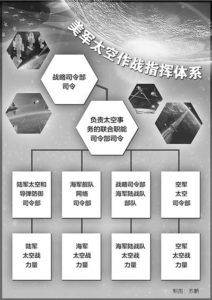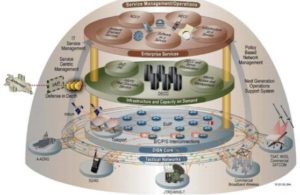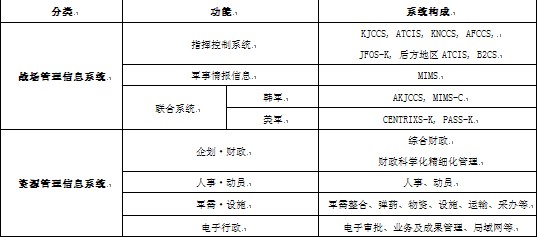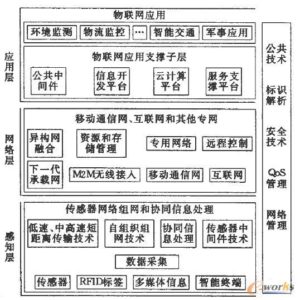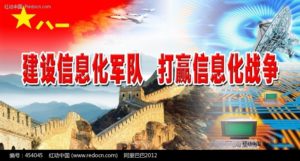China’s Cyberspace National Security Strategy: Actively Defending Network Sovereignty! //
中國的網絡空間國家安全戰略:積極捍衛網絡主權!
According to CCTV news client reports, today (27th) morning, the National Internet Information Office released the “National Cyberspace Security Strategy “, which is the first time China released a strategy on cyberspace security. The “Strategy” clarifies China’s major positions and propositions on the development and security of cyberspace, clarifies the strategic guidelines and main tasks, and is a programmatic document guiding national cybersecurity work.
“Strategy” pointed out that information networks such as the Internet have become a new channel for information dissemination, a new space for production and life, a new engine for economic development, a new carrier for cultural prosperity, a new platform for social governance, a new bond for exchanges and cooperation, and a national sovereignty. New territory. With the in-depth development of information technology, the network security situation is becoming more and more serious. The use of network interference in other countries’ internal affairs and large-scale network monitoring and stealing activities seriously endangers national political security and user information security. The critical information infrastructure has been attacked and destroyed, and major security incidents have occurred. Harmful to national economic security and public interests, network rumors, decadent culture and obscenity, violence, superstition and other harmful information eroding cultural security and youth physical and mental health, cyber terror and illegal crimes directly threaten people’s lives and property security, social order, around cyberspace The international competition for resource control, rulemaking, and strategic initiative is becoming increasingly fierce, and the cyberspace arms race challenges world peace. Cyberspace opportunities and challenges coexist, and opportunities outweigh challenges. We must adhere to active use, scientific development, management according to law, ensure security, resolutely safeguard network security, maximize the utilization potential of cyberspace, better benefit more than 1.3 billion Chinese people, benefit all mankind, and firmly safeguard world peace.
The “Strategy” requires that the overall national security concept should be taken as a guide to implement the development concept of innovation, coordination, green, openness, and sharing, enhance risk awareness and crisis awareness, coordinate the two domestic and international situations, and coordinate the development of two major events. Actively defend and effectively respond to promote the peaceful, secure, open, cooperative, and orderly cyberspace, safeguard national sovereignty, security, and development interests, and realize the strategic goal of building a network power.
The Strategy emphasizes that a safe, stable and prosperous cyberspace is of great significance to all countries and the world. China is willing to work with other countries to respect and uphold cyberspace sovereignty, peacefully utilize cyberspace, manage cyberspace according to law, coordinate network security and development, strengthen communication, expand consensus, deepen cooperation, actively promote global Internet governance system reform, and jointly maintain cyberspace. Peace and security. China is committed to safeguarding the sovereignty, security, and development interests of the country’s cyberspace, promoting the Internet for the benefit of mankind, and promoting the peaceful use and common governance of cyberspace.
The Strategy clarifies that the strategic task of national cyberspace security work in the current and future period is to firmly defend cyberspace sovereignty, resolutely safeguard national security, protect key information infrastructure, strengthen network culture construction, combat cyber terrorism and crimes, and improve the network. Governance system, solid foundation of network security, improvement of cyberspace protection capability, and strengthening international cooperation in cyberspace.

The full text of the National Cyberspace Security Strategy
On December 27th, approved by the Central Network Security and Informatization Leading Group, the National Internet Information Office released the National Cyberspace Security Strategy, the full text of which is as follows.
The widespread use of information technology and the development of cyberspace have greatly promoted economic and social prosperity and progress, but also brought new security risks and challenges. Cyberspace security (hereinafter referred to as cybersecurity) is related to the common interests of mankind, to world peace and development, and to national security. Safeguarding China’s cybersecurity is an important measure to coordinate and promote the comprehensive construction of a well-off society, comprehensively deepen reforms, comprehensively ruling the country according to law, and comprehensively and strictly manage the party’s strategic layout. It is to achieve the goal of “two hundred years” and realize the great Chinese rejuvenation of the Chinese nation. An important guarantee. In order to implement the “Four Principles” of Chairman Xi Jinping’s promotion of the global Internet governance system reform and the “five-point proposal” for building a community of cyberspace destiny, clarify China’s important position on cyberspace development and security, guide China’s cybersecurity work, and maintain The state develops this strategy in the interests of sovereignty, security, and development of cyberspace.
I. Opportunities and challenges
(1) Major opportunities
With the rapid development of the information revolution, the cyberspace composed of the Internet, communication networks, computer systems, automation control systems, digital devices and their applications, services and data is transforming people’s production and life styles and profoundly affecting the history of human society. Development process.
New channels for information dissemination. The development of network technology has broken through the limitations of time and space, expanded the scope of communication, and innovated the means of communication, which triggered a fundamental change in the pattern of communication. The Internet has become a new channel for people to obtain information, learn and communicate, and become a new carrier of human knowledge transmission.
A new space for production and life. In today’s world, the depth of the network is integrated into people’s learning, life, and work. Online education, entrepreneurship, medical care, shopping, and finance are becoming more and more popular. More and more people exchange ideas, achieve careers, and realize their dreams through the Internet.
The new engine of economic development. The Internet has increasingly become the leading force for innovation-driven development. Information technology has been widely used in various industries of the national economy, promoting the upgrading and upgrading of traditional industries, and has spawned new technologies, new formats, new industries, and new models, and promoted the adjustment of economic structure and the transformation of economic development mode. It has injected new impetus into economic and social development.
A new carrier of cultural prosperity. The network promotes cultural exchanges and knowledge popularization, releases the vitality of cultural development, promotes cultural innovation and creation, enriches people’s spiritual and cultural life, and has become a new means of disseminating culture and providing new means of public cultural services. Network culture has become an important part of cultural construction.
A new platform for social governance. The role of the network in promoting the modernization of the national governance system and governance capacity has become increasingly prominent. The application of e-government has become more in-depth, and government information has been publicly shared. It has promoted the scientific, democratic, and rule-based government decision-making, and has smoothed the channels for citizens to participate in social governance. An important way to protect citizens’ right to know, participate, express, and supervise.
A new link for exchanges and cooperation. The interweaving of informationization and globalization has promoted the global flow of information, capital, technology, talents and other factors, and has enhanced the exchange and integration of different civilizations. The Internet has turned the world into a global village, and the international community has increasingly become a community of destiny among you and me.
The new territory of national sovereignty. Cyberspace has become a new field of human activity that is as important as land, sea, sky and space. The expansion of national sovereignty extends to cyberspace, and cyberspace sovereignty has become an important part of national sovereignty. Respecting cyberspace sovereignty, maintaining cybersecurity, seeking common governance, and achieving win-win results are becoming the consensus of the international community.
(2) Severe challenges
The cyber security situation is becoming increasingly severe. The country’s political, economic, cultural, social, and national defense security and citizens’ legitimate rights and interests in cyberspace are facing serious risks and challenges.
Network penetration harms political security. Political stability is the basic prerequisite for national development and people’s happiness. The use of the network to interfere in his internal affairs, attack the political system of other countries, incite social unrest, subvert the political power of other countries, and large-scale network monitoring, network theft and other activities seriously endanger the political security of the country and the security of user information.
Cyber attacks threaten economic security. Network and information systems have become the backbone of critical infrastructure and the entire economic society. Attacks and destruction and major security incidents will lead to rampant infrastructure such as energy, transportation, communications, and finance, causing disastrous consequences and seriously jeopardizing national economic security. And the public interest.
Harmful information on the Internet erodes cultural security. Various ideological and cultural networks on the Internet are in conflict and confrontation, and excellent traditional culture and mainstream values are facing impact. Internet rumors, decadent culture and obscenity, violence, superstition and other harmful information that violates the core values of socialism erodes the physical and mental health of young people, ruin the social atmosphere, mislead value orientation and endanger cultural security. Online morality is out of order, lack of integrity is frequent, and the degree of network civilization needs to be improved.
Cyber terror and illegal crimes undermine social security. Terrorism, separatism, extremism and other forces use the Internet to incite, plan, organize and implement violent terrorist activities, directly threatening people’s lives and property, and social order. Computer viruses, Trojans, etc. spread in the cyberspace. Internet fraud, hacker attacks, intellectual property infringement, and misuse of personal information are abundant. Some organizations deliberately steal user information, transaction data, location information, and corporate trade secrets, seriously damaging the country. , corporate and personal interests, affecting social harmony and stability.
The international competition in cyberspace is on the rise. The international competition for competing for and controlling cyberspace strategic resources, seizing the rule-making power and strategic commanding heights, and seeking strategic initiative is becoming increasingly fierce. Individual countries have strengthened their network deterrence strategies and intensified the cyberspace arms race, and world peace has been challenged by new challenges.
Cyberspace opportunities and challenges coexist, and opportunities outweigh challenges. We must adhere to active use, scientific development, management according to law, ensure security, resolutely safeguard network security, maximize the utilization potential of cyberspace, better benefit more than 1.3 billion Chinese people, benefit all mankind, and firmly safeguard world peace.
Second, the goal
Guided by the overall national security concept, we will implement the development concept of innovation, coordination, green, openness, and sharing, enhance risk awareness and crisis awareness, coordinate the two major domestic and international situations, and coordinate the development of two major events, actively defending and responding effectively. Promote cyberspace peace, security, openness, cooperation, orderly, safeguard national sovereignty, security, development interests, and achieve the strategic goal of building a network power.
Peace: Information technology abuse has been effectively curbed, and activities such as the cyberspace arms race that threaten international peace have been effectively controlled, and cyberspace conflicts have been effectively prevented.
Security: The network security risks are effectively controlled, the national network security assurance system is sound and complete, the core technical equipment is safe and controllable, and the network and information systems are stable and reliable. Network security talents meet the needs, and the society’s cyber security awareness, basic protection skills and confidence in using the network have increased significantly.
Openness: Information technology standards, policies and markets are open and transparent, product circulation and information dissemination are smoother, and the digital divide is increasingly bridging. Regardless of size, strength, or wealth, countries around the world, especially developing countries, can share development opportunities, share development results, and participate fairly in cyberspace governance.
Cooperation: All countries in the world have closer cooperation in the fields of technology exchange, combating cyber terrorism and cybercrime. The multilateral, democratic and transparent international Internet governance system is sound and perfect, and the cyberspace destiny community with cooperation and win-win as the core has gradually formed.
Orderly: The public’s right to know, participation, expression, and supervision in the cyberspace is fully protected, and the privacy of cyberspace is effectively protected and human rights are fully respected. The domestic and international legal systems and standards of cyberspace have been gradually established. The cyberspace has been effectively governed according to law. The network environment is honest, civilized and healthy. The free flow of information and the maintenance of national security and public interests are organically unified.
Third, the principle
A safe, stable and prosperous cyberspace is of great significance to all countries and the world. China is willing to work with other countries to strengthen communication, expand consensus, deepen cooperation, actively promote the transformation of the global Internet governance system, and jointly safeguard cyberspace peace and security.
(1) Respect for maintaining cyberspace sovereignty
The cyberspace sovereignty is inviolable and respects the right of countries to choose their own development path, network management model, Internet public policy and equal participation in international cyberspace governance. The network affairs within the sovereignty of each country are the responsibility of the people of each country. The countries have the right to formulate laws and regulations concerning cyberspace according to their national conditions and draw on international experience, and take necessary measures to manage their own information systems and network activities on their own territory. The domestic information systems and information resources are protected from intrusion, interference, attacks and destruction, guarantee the legitimate rights and interests of citizens in cyberspace; prevent, prevent and punish harmful information that endangers national security and interests from spreading in the domestic network and maintain the cyberspace order. No country engages in cyber hegemony, does not engage in double standards, does not use the network to interfere in its internal affairs, and does not engage in, condone or support network activities that endanger the national security of other countries.
(2) Peaceful use of cyberspace
The peaceful use of cyberspace is in the common interest of mankind. All countries should abide by the UN Charter’s principle of not using or threatening to use force, prevent information technology from being used for the purpose of maintaining international security and stability, and jointly resist the cyberspace arms race and prevent cyberspace conflicts. Adhere to mutual respect, treat each other as equals, seek common ground while reserving differences, embrace mutual trust, respect each other’s security interests and major concerns in cyberspace, and promote the building of a harmonious network world. Oppose the use of national security as an excuse to use technological superiority to control other countries’ networks and information systems, collect and steal data from other countries, and not to seek their own absolute security at the expense of other countries’ security.
(3) Governing cyberspace according to law
We will comprehensively promote the rule of law in cyberspace, adhere to the rule of law, establish networks according to law, and go online according to law, so that the Internet can operate healthily on the rule of law. Establish a good network order according to law, protect the cyberspace information in a legal and orderly free flow, protect personal privacy, and protect intellectual property rights. Any organization or individual who enjoys freedom and exercise rights in cyberspace must abide by the law, respect the rights of others, and be responsible for their words and deeds on the Internet.
(4) Coordinating network security and development
Without cybersecurity, there is no national security. Without informationization, there will be no modernization. Network security and informationization are two wings of the two wings and the drive. Correctly handle the relationship between development and security, adhere to safety and development, and promote safety through development. Security is a prerequisite for development, and any development at the expense of security is difficult to sustain. Development is the foundation of security, and development is the biggest insecurity. Without information development, network security is not guaranteed, and existing security may even be lost.
Fourth, strategic tasks
China’s number of Internet users and network scale is the highest in the world. Maintaining China’s network security is not only its own needs, but also of great significance for maintaining global network security and even world peace. China is committed to safeguarding the sovereignty, security, and development interests of the country’s cyberspace, promoting the Internet for the benefit of mankind, and promoting the peaceful use and common governance of cyberspace.
(1) Firmly defending cyberspace sovereignty
In accordance with the Constitution and laws and regulations, we will manage the network activities within the scope of our sovereignty, protect the security of our information facilities and information resources, and adopt all measures including economy, administration, science and technology, law, diplomacy, and military, and unswervingly safeguard China’s cyberspace sovereignty. Resolutely oppose all acts of subverting our state’s political power and undermining our national sovereignty through the Internet.
(2) Resolutely safeguard national security
Prevent, stop and punish any use of the Internet for treason, secession, sedition, subversion or incitement to subvert the people’s democratic dictatorship; prevent, deter and punish the use of the Internet for theft, disclosure of state secrets and other acts that endanger national security; Prevent, stop and punish foreign forces in the use of the network for infiltration, destruction, subversion and separatist activities.
(iii) Protection of critical information infrastructure
National key information infrastructure refers to information facilities that are related to national security, national economy and people’s livelihood. Once data leakage, destruction or loss of function may seriously endanger national security and public interest, including but not limited to providing services such as public communication and radio and television transmission. Information networks, important information systems in the fields of energy, finance, transportation, education, scientific research, water conservancy, industrial manufacturing, medical and health care, social security, public utilities, and state agencies, and important Internet application systems. Take all necessary steps to protect critical information infrastructure and its critical data from attack. Adhere to the combination of technology and management, focus on protection, prevention, detection, early warning, response, disposal, etc., establish and implement key information infrastructure protection systems, and increase investment in management, technology, talents, and capital. Comprehensively implement policies to effectively strengthen the security protection of key information infrastructure.
The protection of key information infrastructure is the common responsibility of the government, enterprises and the whole society. The competent authorities, operating units and organizations must take necessary measures to ensure the security of key information infrastructures in accordance with the requirements of laws, regulations and system standards, and gradually realize the first evaluation and use. Strengthen risk assessment of key information infrastructure. Strengthen the security protection of party and government organs and websites in key areas, and build and operate the website of grassroots party and government organs in an intensive mode. Establish an orderly sharing mechanism for cyber security information of government, industry and enterprises, and give full play to the important role of enterprises in protecting key information infrastructure.
Adhere to opening up and maintain network security in an open environment. Establish and implement a network security review system, strengthen supply chain security management, conduct security reviews on important information technology products and services purchased by party and government organs and key industries, improve the security and controllability of products and services, and prevent product service providers. And other organizations use the advantages of information technology to implement unfair competition or harm the interests of users.
(4) Strengthening the construction of network culture
Strengthen the construction of online ideological and cultural positions, vigorously cultivate and practice the core values of socialism, implement network content construction projects, develop a positive and upward network culture, spread positive energy, unite powerful spiritual strength, and create a good network atmosphere. Encourage the development of new business, create new products, create a network culture brand that reflects the spirit of the times, and continuously improve the scale of the network culture industry. Implement the China Excellent Culture Online Communication Project and actively promote the digitalization, network production and dissemination of excellent traditional culture and contemporary cultural products. Give full play to the advantages of the Internet communication platform, promote the exchange of excellent cultural exchanges between China and foreign countries, let the people of all countries understand the excellent Chinese culture, let the Chinese people understand the excellent culture of each country, jointly promote the prosperity and development of the network culture, enrich people’s spiritual world, and promote the progress of human civilization.
Strengthen the network ethics and network civilization construction, give play to the role of moral education, and use the excellent results of human civilization to nourish cyberspace and repair the network ecology. Building a civilized and honest network environment, advocating civilized network and civilized Internet access, and forming a safe, civilized and orderly information dissemination order. Resolutely crack down on illegal and harmful information such as rumors, obscenity, violence, superstition, and cults in the cyberspace. Improve the network civilization of young people, strengthen the protection of minors online, and create a good network environment for the healthy growth of young people through the joint efforts of the government, social organizations, communities, schools, and families.
(5) Combating cyber terror and illegal crimes
Strengthen the network’s anti-terrorism, anti-espionage and anti-stealing capabilities, and crack down on cyber terror and cyber espionage activities.
Adhere to comprehensive governance, source control, and legal prevention, and severely crack down on illegal activities such as online fraud, cyber theft, drug trafficking, infringement of citizens’ personal information, dissemination of obscene pornography, hacking, and infringement of intellectual property rights.
(6) Improve the network governance system
Adhere to the rule of law, open and transparent management of the network, and earnestly do the law, the law must be enforced, the law enforcement must be strict, and the law must be investigated. We will improve the network security laws and regulations, formulate laws and regulations such as the Cyber Security Law and the Minor Network Protection Regulations, clarify the responsibilities and obligations of all aspects of society, and clarify the requirements for network security management. Accelerate the revision and interpretation of existing laws to make them applicable to cyberspace. Improve the network security related system, establish a network trust system, and improve the scientific and standardized level of network security management.
Accelerate the construction of a network governance system that combines legal norms, administrative supervision, industry self-discipline, technical support, public supervision, and social education, promotes network social organization management innovation, and improves basic management, content management, industry management, and network crime prevention and combat. Work linkage mechanism. Strengthen the protection of cyberspace communication secrets, freedom of speech, trade secrets, and the legitimate rights and interests of property rights and property rights.
Encourage social organizations to participate in network governance, develop online public welfare undertakings, and strengthen the construction of new types of network social organizations. Encourage netizens to report cyber violations and bad information.
(7) Consolidating the foundation of network security
Adhere to innovation-driven development, actively create a policy environment conducive to technological innovation, pool resources and strength, take enterprises as the main body, combine production, study and research, coordinate research, point-to-face, and overall advancement, and make breakthroughs in core technologies as soon as possible. Pay attention to software security and accelerate the promotion and application of security and trusted products. Develop network infrastructure and enrich cyberspace information content. Implement the “Internet +” initiative and vigorously develop the network economy. Implement national big data strategy, establish a big data security management system, and support next-generation information technology innovation and application such as big data and cloud computing. Optimize the market environment, encourage network security enterprises to become bigger and stronger, and consolidate the industrial foundation for safeguarding national network security.
Establish and improve the national network security technology support system. Strengthen the basic theory of network security and research on major issues. Strengthen network security standardization and certification and accreditation, and make greater use of standards to standardize cyberspace behavior. Do basic work such as level protection, risk assessment, and vulnerability discovery, and improve the network security monitoring and early warning and network security major incident emergency response mechanism.
Implement network security talent project, strengthen the construction of network security disciplines, build a first-class network security college and innovation park, and form an ecological environment conducive to talent cultivation and innovation and entrepreneurship. We will do a good job in the network security publicity week and vigorously carry out publicity and education on the national network security. Promote cybersecurity education into teaching materials, enter the school, enter the classroom, improve the network media literacy, enhance the cyber security awareness and protection skills of the whole society, and improve the identification and resilience of the majority of netizens on illegal criminal activities such as network illegal information and online fraud.
(8) Improving the ability of cyberspace protection

Cyberspace is a new frontier of national sovereignty. We will build a network space protection force that is commensurate with China’s international status and compatible with the network powers. We will vigorously develop network security defense methods, timely discover and resist network intrusion, and build a strong backing for national security.
(9) Strengthening international cooperation in cyberspace
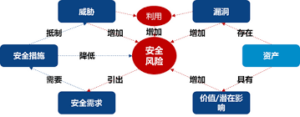
On the basis of mutual respect and mutual trust, we will strengthen international cyberspace dialogue and cooperation and promote the transformation of the Internet global governance system. We will deepen dialogue and exchanges and information communication with bilateral and multilateral networks in various countries, effectively control differences, actively participate in network security cooperation between global and regional organizations, and promote the internationalization of basic resource management such as Internet addresses and root name servers.
Support the United Nations to play a leading role in promoting the development of universally accepted international rules on cyberspace, cyberspace international counter-terrorism conventions, sound judicial assistance mechanisms against cybercrime, deepening policy and law, technological innovation, standards and norms, emergency response, and critical information infrastructure International cooperation in areas such as protection.
Strengthen support for Internet technology diffusion and infrastructure construction in developing and underdeveloped regions, and strive to bridge the digital divide. Promote the construction of the “Belt and Road”, improve the level of international communication and interconnection, and smooth the information silk road. Establish a global Internet sharing and governance platform, such as the World Internet Conference, to jointly promote the healthy development of the Internet. Through active and effective international cooperation, we will establish a multilateral, democratic and transparent international Internet governance system to jointly build a peaceful, secure, open, cooperative and orderly network space.
Original Mandarin Chinese:
據央視新聞客戶端報導,今天(27日)上午,國家互聯網信息辦公室發布了《國家網絡空間安全戰略》,這是我國首次發布關於網絡空間安全的戰略。 《戰略》闡明了中國關於網絡空間發展和安全的重大立場和主張,明確了戰略方針和主要任務,是指導國家網絡安全工作的綱領性文件。

《戰略》指出,互聯網等信息網絡已經成為信息傳播的新渠道、生產生活的新空間、經濟發展的新引擎、文化繁榮的新載體、社會治理的新平台、交流合作的新紐帶、國家主權的新疆域。隨著信息技術深入發展,網絡安全形勢日益嚴峻,利用網絡干涉他國內政以及大規模網絡監控、竊密等活動嚴重危害國家政治安全和用戶信息安全,關鍵信息基礎設施遭受攻擊破壞、發生重大安全事件嚴重危害國家經濟安全和公共利益,網絡謠言、頹廢文化和淫穢、暴力、迷信等有害信息侵蝕文化安全和青少年身心健康,網絡恐怖和違法犯罪大量存在直接威脅人民生命財產安全、社會秩序,圍繞網絡空間資源控制權、規則制定權、戰略主動權的國際競爭日趨激烈,網絡空間軍備競賽挑戰世界和平。網絡空間機遇和挑戰並存,機遇大於挑戰。必須堅持積極利用、科學發展、依法管理、確保安全,堅決維護網絡安全,最大限度利用網絡空間發展潛力,更好惠及13億多中國人民,造福全人類,堅定維護世界和平。
《戰略》要求,要以總體國家安全觀為指導,貫徹落實創新、協調、綠色、開放、共享的發展理念,增強風險意識和危機意識,統籌國內國際兩個大局,統籌發展安全兩件大事,積極防禦、有效應對,推進網絡空間和平、安全、開放、合作、有序,維護國家主權、安全、發展利益,實現建設網絡強國的戰略目標。
《戰略》強調,一個安全穩定繁榮的網絡空間,對各國乃至世界都具有重大意義。中國願與各國一道,堅持尊重維護網絡空間主權、和平利用網絡空間、依法治理網絡空間、統籌網絡安全與發展,加強溝通、擴大共識、深化合作,積極推進全球互聯網治理體系變革,共同維護網絡空間和平安全。中國致力於維護國家網絡空間主權、安全、發展利益,推動互聯網造福人類,推動網絡空間和平利用和共同治理。
《戰略》明確,當前和今後一個時期國家網絡空間安全工作的戰略任務是堅定捍衛網絡空間主權、堅決維護國家安全、保護關鍵信息基礎設施、加強網絡文化建設、打擊網絡恐怖和違法犯罪、完善網絡治理體系、夯實網絡安全基礎、提升網絡空間防護能力、強化網絡空間國際合作等9個方面。
資料圖
《國家網絡空間安全戰略》全文
12月27日,經中央網絡安全和信息化領導小組批准,國家互聯網信息辦公室發布《國家網絡空間安全戰略》,全文如下。
信息技術廣泛應用和網絡空間興起發展,極大促進了經濟社會繁榮進步,同時也帶來了新的安全風險和挑戰。網絡空間安全(以下稱網絡安全)事關人類共同利益,事關世界和平與發展,事關各國國家安全。維護我國網絡安全是協調推進全面建成小康社會、全面深化改革、全面依法治國、全面從嚴治黨戰略佈局的重要舉措,是實現“兩個一百年”奮鬥目標、實現中華民族偉大復興中國夢的重要保障。為貫徹落實習近平主席關於推進全球互聯網治理體系變革的“四項原則”和構建網絡空間命運共同體的“五點主張”,闡明中國關於網絡空間發展和安全的重大立場,指導中國網絡安全工作,維護國家在網絡空間的主權、安全、發展利益,制定本戰略。
一、機遇和挑戰
(一)重大機遇
伴隨信息革命的飛速發展,互聯網、通信網、計算機系統、自動化控制系統、數字設備及其承載的應用、服務和數據等組成的網絡空間,正在全面改變人們的生產生活方式,深刻影響人類社會歷史發展進程。
信息傳播的新渠道。網絡技術的發展,突破了時空限制,拓展了傳播範圍,創新了傳播手段,引發了傳播格局的根本性變革。網絡已成為人們獲取信息、學習交流的新渠道,成為人類知識傳播的新載體。
生產生活的新空間。當今世界,網絡深度融入人們的學習、生活、工作等方方面面,網絡教育、創業、醫療、購物、金融等日益普及,越來越多的人通過網絡交流思想、成就事業、實現夢想。
經濟發展的新引擎。互聯網日益成為創新驅動發展的先導力量,信息技術在國民經濟各行業廣泛應用,推動傳統產業改造升級,催生了新技術、新業態、新產業、新模式,促進了經濟結構調整和經濟發展方式轉變,為經濟社會發展注入了新的動力。
文化繁榮的新載體。網絡促進了文化交流和知識普及,釋放了文化發展活力,推動了文化創新創造,豐富了人們精神文化生活,已經成為傳播文化的新途徑、提供公共文化服務的新手段。網絡文化已成為文化建設的重要組成部分。
社會治理的新平台。網絡在推進國家治理體系和治理能力現代化方面的作用日益凸顯,電子政務應用走向深入,政府信息公開共享,推動了政府決策科學化、民主化、法治化,暢通了公民參與社會治理的渠道,成為保障公民知情權、參與權、表達權、監督權的重要途徑。
交流合作的新紐帶。信息化與全球化交織發展,促進了信息、資金、技術、人才等要素的全球流動,增進了不同文明交流融合。網絡讓世界變成了地球村,國際社會越來越成為你中有我、我中有你的命運共同體。
國家主權的新疆域。網絡空間已經成為與陸地、海洋、天空、太空同等重要的人類活動新領域,國家主權拓展延伸到網絡空間,網絡空間主權成為國家主權的重要組成部分。尊重網絡空間主權,維護網絡安全,謀求共治,實現共贏,正在成為國際社會共識。
(二)嚴峻挑戰
網絡安全形勢日益嚴峻,國家政治、經濟、文化、社會、國防安全及公民在網絡空間的合法權益面臨嚴峻風險與挑戰。
網絡滲透危害政治安全。政治穩定是國家發展、人民幸福的基本前提。利用網絡干涉他國內政、攻擊他國政治制度、煽動社會動亂、顛覆他國政權,以及大規模網絡監控、網絡竊密等活動嚴重危害國家政治安全和用戶信息安全。
網絡攻擊威脅經濟安全。網絡和信息系統已經成為關鍵基礎設施乃至整個經濟社會的神經中樞,遭受攻擊破壞、發生重大安全事件,將導致能源、交通、通信、金融等基礎設施癱瘓,造成災難性後果,嚴重危害國家經濟安全和公共利益。
網絡有害信息侵蝕文化安全。網絡上各種思想文化相互激盪、交鋒,優秀傳統文化和主流價值觀面臨衝擊。網絡謠言、頹廢文化和淫穢、暴力、迷信等違背社會主義核心價值觀的有害信息侵蝕青少年身心健康,敗壞社會風氣,誤導價值取向,危害文化安全。網上道德失範、誠信缺失現象頻發,網絡文明程度亟待提高。
網絡恐怖和違法犯罪破壞社會安全。恐怖主義、分裂主義、極端主義等勢力利用網絡煽動、策劃、組織和實施暴力恐怖活動,直接威脅人民生命財產安全、社會秩序。計算機病毒、木馬等在網絡空間傳播蔓延,網絡欺詐、黑客攻擊、侵犯知識產權、濫用個人信息等不法行為大量存在,一些組織肆意竊取用戶信息、交易數據、位置信息以及企業商業秘密,嚴重損害國家、企業和個人利益,影響社會和諧穩定。
網絡空間的國際競爭方興未艾。國際上爭奪和控製網絡空間戰略資源、搶占規則制定權和戰略制高點、謀求戰略主動權的競爭日趨激烈。個別國家強化網絡威懾戰略,加劇網絡空間軍備競賽,世界和平受到新的挑戰。
網絡空間機遇和挑戰並存,機遇大於挑戰。必須堅持積極利用、科學發展、依法管理、確保安全,堅決維護網絡安全,最大限度利用網絡空間發展潛力,更好惠及13億多中國人民,造福全人類,堅定維護世界和平。
二、目標
以總體國家安全觀為指導,貫徹落實創新、協調、綠色、開放、共享的發展理念,增強風險意識和危機意識,統籌國內國際兩個大局,統籌發展安全兩件大事,積極防禦、有效應對,推進網絡空間和平、安全、開放、合作、有序,維護國家主權、安全、發展利益,實現建設網絡強國的戰略目標。
和平:信息技術濫用得到有效遏制,網絡空間軍備競賽等威脅國際和平的活動得到有效控制,網絡空間衝突得到有效防範。
安全:網絡安全風險得到有效控制,國家網絡安全保障體系健全完善,核心技術裝備安全可控,網絡和信息系統運行穩定可靠。網絡安全人才滿足需求,全社會的網絡安全意識、基本防護技能和利用網絡的信心大幅提升。
開放:信息技術標準、政策和市場開放、透明,產品流通和信息傳播更加順暢,數字鴻溝日益彌合。不分大小、強弱、貧富,世界各國特別是發展中國家都能分享發展機遇、共享發展成果、公平參與網絡空間治理。
合作:世界各國在技術交流、打擊網絡恐怖和網絡犯罪等領域的合作更加密切,多邊、民主、透明的國際互聯網治理體系健全完善,以合作共贏為核心的網絡空間命運共同體逐步形成。
有序:公眾在網絡空間的知情權、參與權、表達權、監督權等合法權益得到充分保障,網絡空間個人隱私獲得有效保護,人權受到充分尊重。網絡空間的國內和國際法律體系、標準規範逐步建立,網絡空間實現依法有效治理,網絡環境誠信、文明、健康,信息自由流動與維護國家安全、公共利益實現有機統一。
三、原則
一個安全穩定繁榮的網絡空間,對各國乃至世界都具有重大意義。中國願與各國一道,加強溝通、擴大共識、深化合作,積極推進全球互聯網治理體系變革,共同維護網絡空間和平安全。
(一)尊重維護網絡空間主權
網絡空間主權不容侵犯,尊重各國自主選擇發展道路、網絡管理模式、互聯網公共政策和平等參與國際網絡空間治理的權利。各國主權範圍內的網絡事務由各國人民自己做主,各國有權根據本國國情,借鑒國際經驗,制定有關網絡空間的法律法規,依法採取必要措施,管理本國信息系統及本國疆域上的網絡活動;保護本國信息系統和信息資源免受侵入、干擾、攻擊和破壞,保障公民在網絡空間的合法權益;防範、阻止和懲治危害國家安全和利益的有害信息在本國網絡傳播,維護網絡空間秩序。任何國家都不搞網絡霸權、不搞雙重標準,不利用網絡干涉他國內政,不從事、縱容或支持危害他國國家安全的網絡活動。
(二)和平利用網絡空間
和平利用網絡空間符合人類的共同利益。各國應遵守《聯合國憲章》關於不得使用或威脅使用武力的原則,防止信息技術被用於與維護國際安全與穩定相悖的目的,共同抵製網絡空間軍備競賽、防範網絡空間衝突。堅持相互尊重、平等相待,求同存異、包容互信,尊重彼此在網絡空間的安全利益和重大關切,推動構建和諧網絡世界。反對以國家安全為藉口,利用技術優勢控制他國網絡和信息系統、收集和竊取他國數據,更不能以犧牲別國安全謀求自身所謂絕對安全。
(三)依法治理網絡空間
全面推進網絡空間法治化,堅持依法治網、依法辦網、依法上網,讓互聯網在法治軌道上健康運行。依法構建良好網絡秩序,保護網絡空間信息依法有序自由流動,保護個人隱私,保護知識產權。任何組織和個人在網絡空間享有自由、行使權利的同時,須遵守法律,尊重他人權利,對自己在網絡上的言行負責。
(四)統籌網絡安全與發展
沒有網絡安全就沒有國家安全,沒有信息化就沒有現代化。網絡安全和信息化是一體之兩翼、驅動之雙輪。正確處理髮展和安全的關係,堅持以安全保發展,以發展促安全。安全是發展的前提,任何以犧牲安全為代價的發展都難以持續。發展是安全的基礎,不發展是最大的不安全。沒有信息化發展,網絡安全也沒有保障,已有的安全甚至會喪失。
四、戰略任務
中國的網民數量和網絡規模世界第一,維護好中國網絡安全,不僅是自身需要,對於維護全球網絡安全乃至世界和平都具有重大意義。中國致力於維護國家網絡空間主權、安全、發展利益,推動互聯網造福人類,推動網絡空間和平利用和共同治理。
(一)堅定捍衛網絡空間主權
根據憲法和法律法規管理我國主權範圍內的網絡活動,保護我國信息設施和信息資源安全,採取包括經濟、行政、科技、法律、外交、軍事等一切措施,堅定不移地維護我國網絡空間主權。堅決反對通過網絡顛覆我國國家政權、破壞我國國家主權的一切行為。
(二)堅決維護國家安全
防範、制止和依法懲治任何利用網絡進行叛國、分裂國家、煽動叛亂、顛覆或者煽動顛覆人民民主專政政權的行為;防範、制止和依法懲治利用網絡進行竊取、洩露國家秘密等危害國家安全的行為;防範、制止和依法懲治境外勢力利用網絡進行滲透、破壞、顛覆、分裂活動。
(三)保護關鍵信息基礎設施
國家關鍵信息基礎設施是指關係國家安全、國計民生,一旦數據洩露、遭到破壞或者喪失功能可能嚴重危害國家安全、公共利益的信息設施,包括但不限於提供公共通信、廣播電視傳輸等服務的基礎信息網絡,能源、金融、交通、教育、科研、水利、工業製造、醫療衛生、社會保障、公用事業等領域和國家機關的重要信息系統,重要互聯網應用系統等。採取一切必要措施保護關鍵信息基礎設施及其重要數據不受攻擊破壞。堅持技術和管理並重、保護和震懾並舉,著眼識別、防護、檢測、預警、響應、處置等環節,建立實施關鍵信息基礎設施保護製度,從管理、技術、人才、資金等方面加大投入,依法綜合施策,切實加強關鍵信息基礎設施安全防護。
關鍵信息基礎設施保護是政府、企業和全社會的共同責任,主管、運營單位和組織要按照法律法規、制度標準的要求,採取必要措施保障關鍵信息基礎設施安全,逐步實現先評估後使用。加強關鍵信息基礎設施風險評估。加強黨政機關以及重點領域網站的安全防護,基層黨政機關網站要按集約化模式建設運行和管理。建立政府、行業與企業的網絡安全信息有序共享機制,充分發揮企業在保護關鍵信息基礎設施中的重要作用。
堅持對外開放,立足開放環境下維護網絡安全。建立實施網絡安全審查制度,加強供應鏈安全管理,對黨政機關、重點行業採購使用的重要信息技術產品和服務開展安全審查,提高產品和服務的安全性和可控性,防止產品服務提供者和其他組織利用信息技術優勢實施不正當競爭或損害用戶利益。
(四)加強網絡文化建設
加強網上思想文化陣地建設,大力培育和踐行社會主義核心價值觀,實施網絡內容建設工程,發展積極向上的網絡文化,傳播正能量,凝聚強大精神力量,營造良好網絡氛圍。鼓勵拓展新業務、創作新產品,打造體現時代精神的網絡文化品牌,不斷提高網絡文化產業規模水平。實施中華優秀文化網上傳播工程,積極推動優秀傳統文化和當代文化精品的數字化、網絡化製作和傳播。發揮互聯網傳播平台優勢,推動中外優秀文化交流互鑑,讓各國人民了解中華優秀文化,讓中國人民了解各國優秀文化,共同推動網絡文化繁榮發展,豐富人們精神世界,促進人類文明進步。
加強網絡倫理、網絡文明建設,發揮道德教化引導作用,用人類文明優秀成果滋養網絡空間、修復網絡生態。建設文明誠信的網絡環境,倡導文明辦網、文明上網,形成安全、文明、有序的信息傳播秩序。堅決打擊謠言、淫穢、暴力、迷信、邪教等違法有害信息在網絡空間傳播蔓延。提高青少年網絡文明素養,加強對未成年人上網保護,通過政府、社會組織、社區、學校、家庭等方面的共同努力,為青少年健康成長創造良好的網絡環境。
(五)打擊網絡恐怖和違法犯罪
加強網絡反恐、反間諜、反竊密能力建設,嚴厲打擊網絡恐怖和網絡間諜活動。
堅持綜合治理、源頭控制、依法防範,嚴厲打擊網絡詐騙、網絡盜竊、販槍販毒、侵害公民個人信息、傳播淫穢色情、黑客攻擊、侵犯知識產權等違法犯罪行為。
(六)完善網絡治理體系
堅持依法、公開、透明管網治網,切實做到有法可依、有法必依、執法必嚴、違法必究。健全網絡安全法律法規體系,制定出台網絡安全法、未成年人網絡保護條例等法律法規,明確社會各方面的責任和義務,明確網絡安全管理要求。加快對現行法律的修訂和解釋,使之適用於網絡空間。完善網絡安全相關製度,建立網絡信任體系,提高網絡安全管理的科學化規範化水平。
加快構建法律規範、行政監管、行業自律、技術保障、公眾監督、社會教育相結合的網絡治理體系,推進網絡社會組織管理創新,健全基礎管理、內容管理、行業管理以及網絡違法犯罪防範和打擊等工作聯動機制。加強網絡空間通信秘密、言論自由、商業秘密,以及名譽權、財產權等合法權益的保護。
鼓勵社會組織等參與網絡治理,發展網絡公益事業,加強新型網絡社會組織建設。鼓勵網民舉報網絡違法行為和不良信息。
(七)夯實網絡安全基礎
堅持創新驅動發展,積極創造有利於技術創新的政策環境,統籌資源和力量,以企業為主體,產學研用相結合,協同攻關、以點帶面、整體推進,盡快在核心技術上取得突破。重視軟件安全,加快安全可信產品推廣應用。發展網絡基礎設施,豐富網絡空間信息內容。實施“互聯網+”行動,大力發展網絡經濟。實施國家大數據戰略,建立大數據安全管理制度,支持大數據、雲計算等新一代信息技術創新和應用。優化市場環境,鼓勵網絡安全企業做大做強,為保障國家網絡安全夯實產業基礎。
建立完善國家網絡安全技術支撐體系。加強網絡安全基礎理論和重大問題研究。加強網絡安全標準化和認證認可工作,更多地利用標準規範網絡空間行為。做好等級保護、風險評估、漏洞發現等基礎性工作,完善網絡安全監測預警和網絡安全重大事件應急處置機制。
實施網絡安全人才工程,加強網絡安全學科專業建設,打造一流網絡安全學院和創新園區,形成有利於人才培養和創新創業的生態環境。辦好網絡安全宣傳周活動,大力開展全民網絡安全宣傳教育。推動網絡安全教育進教材、進學校、進課堂,提高網絡媒介素養,增強全社會網絡安全意識和防護技能,提高廣大網民對網絡違法有害信息、網絡欺詐等違法犯罪活動的辨識和抵禦能力。
(八)提升網絡空間防護能力

網絡空間是國家主權的新疆域。建設與我國國際地位相稱、與網絡強國相適應的網絡空間防護力量,大力發展網絡安全防御手段,及時發現和抵禦網絡入侵,鑄造維護國家網絡安全的堅強後盾。
(九)強化網絡空間國際合作
在相互尊重、相互信任的基礎上,加強國際網絡空間對話合作,推動互聯網全球治理體系變革。深化同各國的雙邊、多邊網絡安全對話交流和信息溝通,有效管控分歧,積極參與全球和區域組織網絡安全合作,推動互聯網地址、根域名服務器等基礎資源管理國際化。
支持聯合國發揮主導作用,推動制定各方普遍接受的網絡空間國際規則、網絡空間國際反恐公約,健全打擊網絡犯罪司法協助機制,深化在政策法律、技術創新、標準規範、應急響應、關鍵信息基礎設施保護等領域的國際合作。

加強對發展中國家和落後地區互聯網技術普及和基礎設施建設的支持援助,努力彌合數字鴻溝。推動“一帶一路”建設,提高國際通信互聯互通水平,暢通信息絲綢之路。搭建世界互聯網大會等全球互聯網共享共治平台,共同推動互聯網健康發展。通過積極有效的國際合作,建立多邊、民主、透明的國際互聯網治理體系,共同構建和平、安全、開放、合作、有序的網絡空間。
Original Referring URL: https://military.china.com/important/
